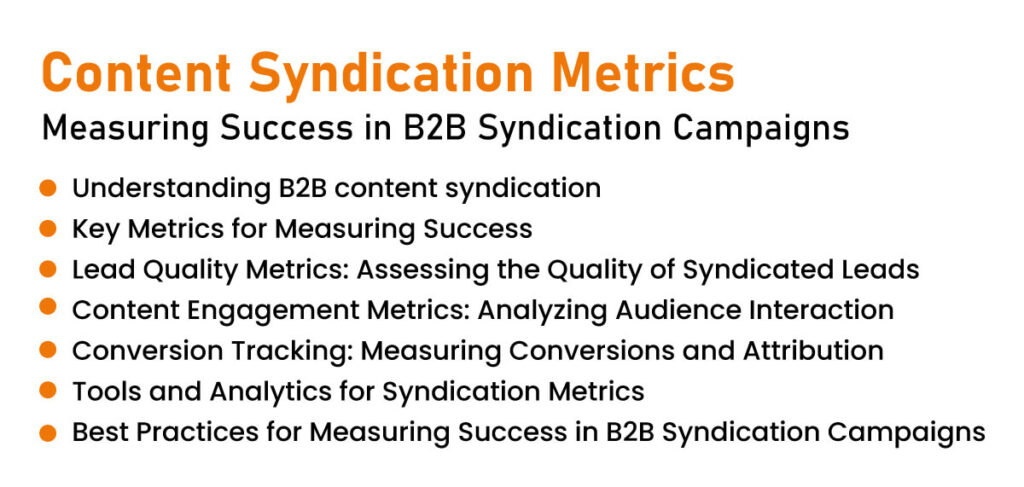
In the dynamic and ever-changing B2B environment, content syndication has emerged as a powerful strategy for organizations to enhance their brand’s visibility and generate valuable leads. To effectively gauge the effectiveness of B2B syndication campaigns, it is crucial to measure the right metrics.
This blog explores the significance of content syndication metrics in measuring success. We will delve into essential metrics such as Syndication ROI, lead quality metrics, content engagement metrics, conversion tracking, and content syndication analytics.
By leveraging these metrics, businesses can gain valuable insights, optimize their strategies, and maximize the impact of their content syndication initiatives. Join us as we uncover the key metrics that drive success in B2B syndication campaigns.
Must Read: 14 Expert Tips to Boost Your Blog Traffic with Content Syndication
Evaluating Success in B2B Syndication Campaigns: A Focus on Content Syndication Metrics
Table of Contents
- 1 Evaluating Success in B2B Syndication Campaigns: A Focus on Content Syndication Metrics
- 2 Key Metrics for Measuring Success

Understanding B2B Content Syndication:
Before diving into the metrics, let’s establish a clear understanding of B2B content syndication. It involves partnering with content syndication platforms or networks to distribute valuable and informative content to a broader audience beyond a company’s owned channels.
By doing so, businesses can leverage the readership of established and reputable websites, industry publications, and relevant platforms, thus increasing brand visibility, credibility, and generating nrew leads.
According to a recent study by Demand Gen Report, 78% of B2B buyers use whitepapers to make purchasing decisions, making content syndication an effective strategy to reach and engage with these decision-makers.
Must Read: The Ultimate Lead Generation Content Syndication Strategy
Key Metrics for Measuring Success
Lead Quality Metrics:
Assessing the Quality of Syndicated Leads:
One of the primary objectives of content syndication is to generate high-quality B2B leads that are more likely to convert into customers.
Evaluating lead quality is crucial to determine the success of a syndication campaign. Let’s explore some key metrics in this regard.
Conversion Rate:
Measuring the percentage of syndicated leads that convert into desired actions, such as filling out a form, downloading a resource, or requesting a demo.
According to a study by MarketingSherpa, top-performing companies have an average conversion rate of 5.31% for their content syndication efforts. This showcases the significance of optimizing campaigns to maximize conversion rates.
Sales Qualified Leads (SQLs):
Identifying the number of leads that meet specific qualification criteria set by your sales team, indicating a higher chance of conversion.
According to HubSpot, companies that focus on generating high-quality lead through content syndication experience a 45% higher sales achievement. This highlights the importance of prioritizing lead quality to drive sales success.
Cost per Lead (CPL):
Calculating the cost associated with acquiring each syndicated lead. This metric allows businesses to evaluate the efficiency of their campaign and optimize their budget allocation.
According to a study by Demand Metric, the average cost per lead for content syndication is $43, making it a cost-effective strategy compared to other lead generation methods.
This data emphasizes the potential cost savings that content syndication can offer while delivering valuable leads.
Businesses can improve their targeting techniques, evaluate the return on investment (ROI) of their syndication efforts, and generate more quality leads that are more likely to become customers by measuring these KPIs.
Must Read: Utilizing Intelligent Content Syndication To Produce High Intent MQLs
Content Engagement Metrics:
Examining the Interaction of the Audience Understanding how the target audience interacts with syndicated content is necessary to gauge the success of a syndication endeavor. Let’s examine some crucial statistics for this group.
Click-through Rate (CTR):
Measuring the percentage of users who click on syndicated content, indicating their interest and intent to engage further.
The average CTR for B2B content syndication efforts is roughly 0.5%, according to a survey by the Content Marketing Institute.
This information emphasizes the significance of content optimization to increase click-through rates and draw in the intended audience.
Time on Page:
Analyzing the average time visitors spend engaging with syndicated content, which reflects their level of interest and attention.
According to studies, visitors are more likely to convert the longer they spend on a page. According to a survey by Nielsen Norman Group, visitors spend an average of 15 seconds on a web page, underscoring the significance of grabbing and holding their attention.
This data emphasizes the need for engaging and captivating content to keep the audience engaged and increase the chances of conversion.
Bounce Rate:
Assessing the percentage of visitors who navigate away from syndicated content without taking any further action, indicating a lack of relevance or engagement.
According to Google, the average bounce rate for B2B websites is approximately 60%, making it crucial to optimize content syndication campaigns to reduce bounce rates.
This data emphasizes the importance of delivering relevant and valuable content that keeps visitors engaged and encourages them to explore further.
Businesses may learn a lot about the effectiveness of their content by tracking these engagement data. They can also determine the types of material that resonate most with their target audience and adjust their future syndication initiatives appropriately.
Conversion Tracking:
Measuring Conversions and Attribution: Measuring conversions and attributing them to the proper syndication efforts are essential for determining the success of a B2B syndication campaign. Let’s explore some vital metrics in this type.
Conversion Rate:
Calculating the percentage of syndicated leads that convert into paying customers or complete a desired action, such as making a purchase or signing up for a service.
According to a study by Econsultancy, the average conversion rate for B2B companies is 2.23%, featuring the significance of optimizing campaigns to maximize conversions.
This data underscores the importance of driving conversions and highlights the potential for growth through effective content syndication campaigns.
Must Read: MQL to SQL Conversion Rate
Multi-Touch Attribution:
Determining which touchpoints along the buyer’s journey contribute most to conversions, allowing businesses to optimize their syndication strategy accordingly.
A study by Salesforce found that companies using multi-touch attribution models achieve a 15% higher conversion rate compared to those using single-touch attribution.
This data highlights the importance of tracking and understanding the customer journey to allocate resources effectively and drive higher conversion rates.
Return on Ad Spend (ROAS):
Evaluating the revenue generated from syndicated content in relation to the advertising spend. According to a survey by AdRoll, companies that achieve a ROAS of 6:1 or higher consider their campaigns successful.
This metric provides a clear picture of the campaign’s profitability and helps allocate resources effectively. This data emphasizes the importance of assessing the financial impact of content syndication campaigns and optimizing advertising spend for maximum returns.
By accurately measuring conversions and attributing them to the appropriate syndication efforts, businesses can optimize their ROI, allocate resources effectively, and refine their syndication strategies to drive more conversions.
Must Read: A Brief Guide to Generate Leads Using ABM Content Syndication
Tools and Analytics for Syndication Metrics:
To track and analyze the above metrics, several tools and analytics platforms can greatly assist businesses in their syndication efforts. Let’s explore some popular options.
Google Analytics:
A comprehensive web analytics platform that provides insights into website traffic, user behavior, conversions, and more. It offers robust features for tracking and analyzing syndication metrics, such as CTR, time on page, and bounce rate.
This data highlights the importance of utilizing advanced analytics tools to gain a comprehensive understanding of syndication campaign performance.
Marketing Automation Platforms:
Solutions like HubSpot, Marketo, or Pardot offer advanced tracking and reporting capabilities, allowing businesses to measure lead quality, conversion rates, and other relevant metrics.
These platforms integrate with content syndication campaigns to provide comprehensive analytics. This data emphasizes the benefits of leveraging marketing automation platforms to streamline data analysis and gain actionable insights.
Syndication Platform Analytics:
Many content syndication platforms provide built-in analytics tools to monitor the performance of syndication campaigns, offering insights into clicks, impressions, conversions, and other key metrics specific to syndicated content.
Examples of such platforms include Outbrain, Taboola, and LinkedIn Lead Gen Forms. This data showcases the availability of specialized analytics tools within content syndication platforms, enabling businesses to track and optimize campaign performance efficiently.
Leveraging these tools and analytics platforms empowers businesses to gain a comprehensive understanding of their syndication campaign’s performance, make data-driven decisions, and optimize their strategies accordingly.
Best Practices for Measuring Success in B2B Syndication Campaigns:
To maximize the effectiveness of content syndication efforts and accurately measure success, it is essential to follow best practices on how to measure content syndication. Let’s explore some key practices.
Clearly Define Goals:
Establish specific, measurable goals for syndication campaigns, such as the number of leads generated, target conversion rates, or revenue generated. This clarity helps in selecting the most relevant metrics for tracking success and aligning efforts with objectives.
Align Metrics with Objectives:
Select metrics that directly align with goals and provide actionable insights. Avoid getting overwhelmed by tracking too many metrics and focus on those that truly drive business growth and align with campaign objectives.
This approach ensures a focused and meaningful analysis of syndication campaign performance.
Implement UTM Parameters:
Utilize UTM parameters in syndicated URLs to track the source, medium, and campaign associated with each click. This information enables accurate attribution of conversions and helps in optimizing campaigns.
Implementing UTM parameters facilitates precise tracking and attribution, providing valuable insights for campaign optimization.
A/B Testing:
Experiment with different variations of syndicated content to identify what resonates best with the target audience. A/B testing allows businesses to compare metrics across different content assets and optimize accordingly.
This data-driven approach enables businesses to refine their content and delivery strategies to maximize engagement and conversion rates.
Continual Optimization:
Regularly analyze syndication metrics and make data-driven decisions to optimize campaigns. Identify underperforming channels, adjust targeting parameters, or refine content to improve results over time.
Continuous optimization is key to maximizing the success of syndication campaigns. This practice emphasizes the importance of ongoing monitoring, analysis, and refinement to achieve optimal results.
In conclusion, measuring success in B2B content syndication campaigns, whether through paid platforms or even free content syndication channels, requires a thorough understanding of key metrics and their significance.
By assessing lead quality metrics, content engagement metrics, and conversion tracking, businesses can gain valuable insights to optimize their syndication efforts effectively.
Leveraging the right tools and analytics platforms, such as Google Analytics, marketing automation platforms, and syndication platform analytics, enables accurate tracking and analysis of syndication metrics.
By following best practices and continually optimizing campaigns, businesses can achieve a higher ROI and drive sustainable growth through content syndication.

Vikas Bhatt is the Co-Founder of ONLY B2B, a premium B2B lead generation company that specializes in helping businesses achieve their growth objectives through targeted marketing & sales campaigns. With 10+ years of experience in the industry, Vikas has a deep understanding of the challenges faced by businesses today and has developed a unique approach to lead generation that has helped clients across a range of industries around the globe. As a thought leader in the B2B marketing community, ONLY B2B specializes in demand generation, content syndication, database services and more.

.webp)
